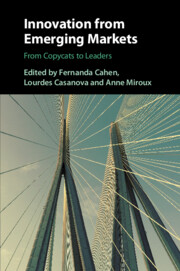Book contents
- Innovation from Emerging Markets
- Innovation from Emerging Markets
- Copyright page
- Contents
- Figures
- Tables
- Boxes
- Contributors
- Foreword
- Acknowledgments
- Introduction
- 1 A Framework for Innovation in Emerging Markets
- Part I Drivers of Innovation in Emerging Markets
- 2 The Breadth and Extent of Chinese Innovation as Documented in the 2017 Corporate Innovation Survey
- 3 The Rise of an Innovation Tiger
- 4 Exploring the Role of Government Involvement in Innovation
- 5 Digital Companies Driving Business Model Innovation in Emerging Markets
- 6 Entrepreneurial Ecosystems and Innovation in the Balkans
- Part II Types of Innovation in Emerging Markets
- Part III Innovation Outcomes in Emerging Markets
- Conclusions
- Index
- References
3 - The Rise of an Innovation Tiger
The Catch-Up of the Indian National System of Innovation
from Part I - Drivers of Innovation in Emerging Markets
Published online by Cambridge University Press: 15 March 2021
- Innovation from Emerging Markets
- Innovation from Emerging Markets
- Copyright page
- Contents
- Figures
- Tables
- Boxes
- Contributors
- Foreword
- Acknowledgments
- Introduction
- 1 A Framework for Innovation in Emerging Markets
- Part I Drivers of Innovation in Emerging Markets
- 2 The Breadth and Extent of Chinese Innovation as Documented in the 2017 Corporate Innovation Survey
- 3 The Rise of an Innovation Tiger
- 4 Exploring the Role of Government Involvement in Innovation
- 5 Digital Companies Driving Business Model Innovation in Emerging Markets
- 6 Entrepreneurial Ecosystems and Innovation in the Balkans
- Part II Types of Innovation in Emerging Markets
- Part III Innovation Outcomes in Emerging Markets
- Conclusions
- Index
- References
Summary
The rise of India’s national system of innovation (NSI) reflects a rapid catch-up process toward developed country innovation standards. However, industries have evolved at a varying pace, reflecting influences by government-driven activities, while others are more influenced by business strategies. Government policies and firm strategies have co-evolved with one another and a variety of endogenous/domestic and exogenous/foreign pressures. We analyze the impact of these pressures on locally based innovation processes within the Indian NSI. We examine three disparate industrial contexts: the wind turbine, pharmaceutical, and auto component industries, and present evidence of considerable industry-specific effects. Domestic firms largely drove innovation in the Indian wind turbine and pharmaceutical industries, drawing knowledge from abroad through various means. In contrast, innovation in the auto components industry was driven by domestic firms’ participation in global value chains coordinated by advanced country MNCs. Eventually, these domestic firms become eMNCs in their own right, some becoming global competitors. Our chapter contributes to the debates related to innovation policies, NSIs and the catch-up processes of eMNCs.
Keywords
- Type
- Chapter
- Information
- Innovation from Emerging MarketsFrom Copycats to Leaders, pp. 63 - 94Publisher: Cambridge University PressPrint publication year: 2021



